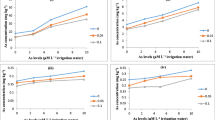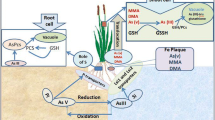Abstract
Long-term use of arsenic contaminated groundwater to irrigate crops, especially paddy rice (Oryza sativaL.) has resulted in elevated soil arsenic levels in Bangladesh. There is, therefore, concern regarding accumulation of arsenic in rice grown on these soils. A greenhouse pot experiment was conducted to evaluate the impact of arsenic-contaminated irrigation water on the growth and uptake of arsenic into rice grain, husk, straw and root. There were altogether 10 treatments which were a combination of five arsenate irrigation water concentrations (0–8 mg As l−1) and two soil phosphate amendments. Use of arsenate containing irrigation water reduced plant height, decreased rice yield and affected development of root growth. Arsenic concentrations in all plant parts increased with increasing arsenate concentration in irrigation water. However, arsenic concentration in rice grain did not exceed the maximum permissible limit of 1.0 mg As kg−1. Arsenic accumulation in rice straw at very high levels indicates that feeding cattle with such contaminated straw could be a direct threat for their health and also, indirectly, to human health via presumably contaminated bovine meat and milk. Phosphate application neither showed any significant difference in plant growth and development, nor in As concentrations in plant parts.
Similar content being viewed by others
References
Abedin M J, Cresser M S, Feldmann J and Meharg A A, Feldmann J and Cotter-Howells J 2002 Uptake kinetics of arsenic species in rice (Oryza sativa L.) plants. Plant Physiol. 128, 1120-1128.
Alam M B and Sattar M A 2000 Assessment of arsenic contamination in soils and waters in some areas of Bangladesh. Water Sci. Tech. 42, 185-193.
Asher C J and Reay P F 1979 Arsenic uptake by barley seedlings. Aust. J. Plant Physiol. 6, 459-466.
BGS (British Geological Survey) 2000 Executive summary of the main report of Phase I, Groundwater Studies of Arsenic Contamination in Bangladesh, by British Geological Survey and Mott MacDonald (UK) for the Government of Bangladesh, Ministry of Local Government, Rural Development and Cooperatives, Department of Public Health Engineering, and Department for International Development (UK). (URL: http://www.dainichiconsul.co.jp/english/ar ticle/DFID-sum.html).
Carbonell-Barrachina A A, Arabi M A, DeLaune R D, Gambrell R P and Patrick W H Jr 1998 The influence of arsenic chemical form and concentration on Spartina petens and Spartina alterniflora growth and tissue arsenic concentration. Plant Soil 198, 33-43.
Carbonell-Barrachina A A, Burlo F, Valero D, Lopez E, Martinez-Romero D and Martinez-Sanchez F 1999 Arsenic toxicity and accumulation in turnip as affected by arsenic chemical speciation. J. Agric. Food Chem. 47, 2288-2294.
Creger T L and Peryea F J 1994 Phosphate fertilizer enhances arsenic uptake by Apricot Liners grown in lead-arsenate-enriched soil. Hort. Sci. 29, 88-92.
Cullen W R and Reimer K J 1989 Arsenic speciation in the environment. Chem. Rev. 89, 713-764
Davenport J R and Peryea F J 1991 Phosphate fertilizers influence leaching of lead and arsenic in a soil contaminated with lead arsenate. Water Air Soil Pollut. 57-58, 101-110.
Dey M M, Miah M N I, Mustafi B A A and Hossain M 1996 Rice production constraints in Bangladesh: Implications for further research priorities. In Rice research in Asia: Progress and priorities. Eds. RE Evenson, R W Herdt and M Hossain. pp 179-191. CAB International, Wallingford, UK and International Rice Research Institute, Manila, Philippines.
Feldmann J, John K and Pengprecha P 2000 Arsenic metabolism in seaweed-eating sheep from Northern Scotland. Fresenius J. Anal. Chem. 368, 116-121.
Feldmann J, Balger T, Hansen H and Pengprecha P 2001 In Plasma Mass Spectrometry: The New Millenium. Eds. J G Holland and S D Tanner. pp 380-386. The Royal Society of Chemistry, Cambridge, UK.
Frans R, Horton D and Burdette L 1988 Influence of MSMA on straighthead, arsenic uptake and growth response in rice (Oryza sativa). Arkansas AES.Rep. Ser. 302, 1-12.
Gilmour J T and Wells B R 1980 Residual effect of MSMA on sterility in rice cultivars. Agron. J. 72, 1066-1067.
Hartley-Whitaker J, Ainsworth G, Vooijs R, Bookum T W, Schat H and Meharg A A 2000 Phytochelatins are involved in differential arsenate tolerance in Holcus lanatus. Plant Physiol. 126, 299-306.
Hartley-Whitaker J, Ainsworth G and Meharg A A 2001 Copperand arsenate-induced oxidative stress in Holcus lanatus L. clones with differential sensitivity. Plant Cell Environ. 24, 713-722.
Hingston F J, Posner A M and Quirk J P 1972 Competitive adsorption of negatively charged ligands on oxide surfaces. Faraday Discuss. Chem. Soc. 52, 334-342.
Lee R B 1982 Selectivity of kinetics of ion uptake by barley plants following nutrient deficiency. Ann. Bot. 50, 429-449.
Lindsay W L and Norvell W A 1978 Development of a DTPA soil test for zinc, iron, manganese, and copper. Soil Sci. Soc. Am. J. 42, 421-428.
Liu G L and Gao S D 1987 The effect of arsenic in red soil on crops. J. Soil Sci. (China) 18, 231-233.
Maitani T, Kubota H, Sato K and Yamada T 1996 The composition of metals bound to class III metallothioein (phytochelatin and its desglycyl peptide) induced by various metals in root cultures of Rubia tinctorum. Plant Physiol. 110, 1145-1150.
Marin A R, Masscheleyn P H and Patrick W H Jr 1992 The influence of chemical form and concentration of arsenic on rice growth and tissue arsenic concentration. Plant Soil 139, 175-183.
Marin A R, Pezeshki S R, Masscheleyn P H and Choi H S 1993a Effect of dymethylarsenic acid (DMAA) on growth, tissue arsenic, and photosynthesis of rice plants. J. Plant Nutr. 16, 865-880.
Marin A R, Masscheleyn P H and Patrick W H Jr 1993b Soil redoxpH stability of arsenic species and its influence on arsenic uptake by rice. Plant Soil 152, 245-253.
Masscheleyn P H, DeLaune R D and Patrick W H Jr 1991 Effect of redox potential and pH on arsenic speciation and solubility in a contaminated soil. Environ. Sci. Technol. 25, 1414-1419.
Meharg A A and Macnair M R 1992 Suppression of the high affinity phosphate uptake system: a mechanism of arsenate tolerance in Holcus lanatus L. J Exp. Bot. 43, 519-524.
Meharg A A and Macnair M R 1994 Relationship between plant phosphorus status and kinetics of arsenate influx in clones of Deschampsia caspitosa (L.) Beauv. that differ in their tolerance to arsenate. Plant Soil 162, 99-106.
Meharg A A, Naylor J and Macnair M R 1994 Phosphorus nutrition of arsenate-tolerant and nontolerant phenotypes of velvetgrass. J Environ. Qual. 23, 234-238.
Merry R H, Tiller K G and Alston A M 1986 The effects of contamination of soil with copper, lead and arsenic on the growth and composition of plants I. Effects of season, genotype, soil temperature and fertilizers. Plant Soil 91, 115-128.
Milam M R, Marin A, Sedberry J E Jr, Bligh D P and Sheppard R 1988 Effect of water managenent, arsenic, and zinc on selected agronomic traits and rice grain yield. In Annual Progress Report, pp 105-108. Northeast Research Station and Macon Ridge Research Station, Baton Rouge, USA.
Mylona P V, Polidoros A N and Scandalios J G 1998 Modulation of antioxidant responses by arsenic in maize. Free Radical Biol. Med. 25, 576-585.
National Food Authority 1993 'Australian Food Standard Code: March, 1993'. Australian Govt. Pub. Service, Canberra.
Nicholson F A, Chambers B J, Williams J R and Unwin R J 1999 Heavy metal contents of livestock feeds and animal manures in England and Wales. Bioresour. Technol. 70, 23-31.
Nissen P and Benson A A 1982 Arsenic metabolism in fresh tion of arsenic by phytochelatins in plants. Plant Physiol. 122, 793-801 (water and terrestrial plants. Physiol. Plantarum. 54, 446-450).
Onken B M and Hossner L R 1995 Plant uptake and determination of arsenic species in soil solution under flooded conditions. J. Environ. Qual. 24, 373-381.
Onken B M and Hossner L R 1996 Determination of arsenic species in soil solution under flooded conditions. Soil Sci. Soc. Am. J. 60, 1385-1392.
Page A L, Miller R H and Keeney D R 1982. In Methods of Soil Analysis Part 2: Chemical and Microbiological properties (2nd edn.), SSSA, Madison, WI.
Peryea F J and Kammereck R 1997 Phosphate-enhanced movement of arsenic out of lead arsenate-contaminated topsoil and through uncontaminated sub soil. Water Air Soil Pollut. 93, 243-254.
Samanta G, Chowdhury T R, Mandal B K, Biswas B K, Chowdhury U K, Basu G K, Chanda C R, Lodh D and Chakraborti D 1999 Flow injection hydride generation atomic absorption spectrometry for determination of arsenic in water and biological samples from arsenic-affected districts of West Bengal, India and Bangladesh. Microchem. J. 62, 174-191.
Schmöger M E V, Oven M and Grill E 2000 Detoxification of arsenic by phytochelatins in plants. Plant Physiol. 122, 793-801.
Shariatpanahi M and Anderson A C 1984 Distribution and toxicity of monosodium methanearsonate following oral administration of the herbicide to dairy sheep and goats. J. Environ. Sci. Health B19, 427-439.
Sharples J M, Meharg A A, Chambers S M and Cairney J W G 2000 Mechanism of arsenate resistance in the Ericoid mycorrhizal fungus Hymenoscyphus ericae. Plant Physiol. 124, 1327-1334.
Sneller E F C, Van Heerwaarden L M, Kraaijeveld-Smit F J L, Ten Bookum W M, Koevoets P L M, Schat H and Verkleij J A C 1999 Toxicity of arsenate in Silene vulgaris, accumulation and degradation of arsenate-induced phytochelatins. New Phytol. 144, 223-232.
SOES (School of Environmental Studies) and DCH (Dhaka Community Hospital) 2000 Groundwater arsenic contamination in Bangladesh A. Summary of 239 days field survey from August 1995 to February, 2000; B. Twenty seven days detailed field survey information from April 1999 to February 2000. School of Environmental Studies, Jadavpur University, Calcutta, India and Dhaka Community Hospital, Dhaka, Bangladesh.
Tang T and Miller D M 1991 Growth and tissue composition of rice grown in soil treated with inorganic copper, nickel, and arsenic. Commun. Soil Sci. Plant Anal. 22, 2037-2045.
Tondel M, Rahman M, Magnuson A, Chowdhury I A, Faruquee M H and Ahmad S A 1999 The relationship of arsenic levels in drinking water and the prevalence rate of skin lesions in Bangladesh. Environ. Health Persp. 107, 727-729.
Tsutsumi M 1980 Intensification of arsenic toxicity to paddy rice by hydrogen sulphide and ferrous iron I. Induction of bronzing and iron accumulation in rice by arsenic. Soil Sci. Plant Nutr. 26, 561-569.
Ullah S M 1998 Arsenic contamination of groundwater and irrigated soils of Bangladesh. In Abstracts: International Conference on Arsenic Pollution of Ground Water in Bangladesh: causes, effects and remedies. 8-12 February 1998, Dhaka Community Hospital, Dhaka, Bangladesh, p 133.
Ullrich-Eberius C I, Sanz A and Novacky A J 1989 Evaluation of arsenate and vandate-associated changes of electrical membrane potential and phosphate transport in Lemna gibba GI. J. Exp. Bot. 40, 119-128.
UNICEF 2001 Arsenic mitigation in Bangladesh. URL: http//www.unicef.org/arsenic.
Watanabe F S, and Olsen S R 1965 Test of an ascorbic acid method for determining phosphorus in water and NaHCO3 extracts from soil. Soil Sci. Soc. Am. Proc. 29, 677-678.
WHO 2001 Arsenic in Drinking water. URL: http://www.who.int/inf-fs/en/fact 210.html.
Woolson E A, Axley J H and Kearney P C 1973 The chemistry and phytotoxicity of arsenic in soils: II. Effects of time and phosphorus. Soil Sci. Soc. Am. Proc. 37, 254-259.
Woolson E A 1977 Generation of alkylarsines from soil. Weed Sci. 25, 412-416.
Xie Z and Huang C 1994 Relatioship between lead, zinc and arsenic contents and rice tillering in the soil rice system. J. Zhejiang Agril. Univ. (China) 20, 67-71.
Xie Z M and Huang C Y 1998 Control of arsenic toxicity in rice plants grown on an arsenic-polluted paddy soil. Commun. Soil Sci. Plant Anal. 29, 2471-2477.
Author information
Authors and Affiliations
Corresponding author
Rights and permissions
About this article
Cite this article
Abedin, M.J., Cotter-Howells, J. & Meharg, A.A. Arsenic uptake and accumulation in rice (Oryza sativa L.) irrigated with contaminated water. Plant and Soil 240, 311–319 (2002). https://doi.org/10.1023/A:1015792723288
Issue Date:
DOI: https://doi.org/10.1023/A:1015792723288




